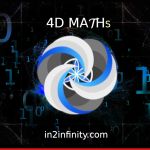Welcome to into infinity broadcasting the solutions to pie. And today we’re going to be talking about the structure of infinite number space. To start with, it might be, if we just recap, we had a talk a little while ago, where we just showed the algebra doesn’t make any sense in the fourth dimension. The numbers can equal anything. We’ll just go back through that process again. For those who missed very quickly. We’ll just take the number zero. We’re going to set up a simple algorithm, zero divided by one and then we’re going to form that calculation and then we’re going to plus one, and once we get the result, we’re going to take that into the next row. And we’re going to divide that by one and we’re going to plus one we’re gonna divide that by one plus one and so on, so on. And as we go, so on and so on and so on. What happens is we create sets of numbers we create actually three sets of numbers for those who are really observant, three ordinal numbers, and one cart two or sorry, two ordinal numbers and one cardinal. And so zero starts the affair, and we go from zero and it goes all the way from zero to infinity. And you have the plus one one set is greater than the other. Yeah. So because it includes zero, yeah, so that’s the that’s the that’s the upshot. So what happens is if you are going to the negative, so instead of plus one, we’re going to plus minus one, and we’re going to divide by minus one. What suddenly happens is that we get a binary code suddenly, yeah. And that so rather than progressing through the numbers, we’re going to now progress along a straight line 1010101010 If you think about that, so and then when you terminate if you stop the calculation, the the calculation will flip into the positive and suddenly you’ll get a positive number flip, which means, hey, we’ve stopped accounting. So you can see how we mentioned about how consciousness kind of works, isn’t it? We count the numbers. We stopped counting. And we presume, hey, that’s the number. Yeah, but really, we’re just extrapolating that particular thing out of the infinite, that’s what’s actually happening. And that’s what we do in reality. And when we do, we can always add one, and we can always minus one. That’s what the nature of infinity is plus or minus one. And so when we flip that inversion, that’s what we have on the other side on on the negative side. But if you think about it, well that’s really done is that’s created like this kind of particular number structure, whereby we increase through our ordinal counting first, second, third, fourth, fifth, and so on. Then we are actually moving through on one side, a number count 1-234-567-8910. And on the other side, we’re flipping from zero to one zero to one zero to one, or minus one. And what we’re seeing then is actually each one of those is the lining itself with either a even number or an odd number. So there we are, we have two types of number, an odd number, an even number and they are designated specifically one and zero for that particular purpose, which is quite handy when it comes to programming computers. As we do with quantum computing. Anyway. In the next step, what we’ll do is we’ll take the same algorithm so the same algorithm, what that does, is nothing changes. Yeah, we’re not going to change, we’re still going to divide, we’re still going to pass but the only thing we’re gonna change now is going to change the number one for the number two, we’re going to exchange number one for number two. If we do that, with the first with the with the with the calculation, before we changed it, we went from zero and we changed it to two what you’ll get is you get plus one, plus one plus two minus plus two minus one plus two minus one plus two so and so forth on the negative side. And if you go into the positive side, what you will see is the numbers will just go from two on to infinity. So we’ve actually got what are called minus infinity minus of minus two point Yeah, well, actually or minus three if you include the zero. So it depends whether you include two or not. Yeah, and that all depends on whether you’re counting your ordinals or your Cardinals which is why we keep track of the two sets of number types, and fourth dimensional mathematics. Once at time, on set space, we actually have two sets of cardinals, two sorry, two sets, there are two sets of ordinals for every cardinal and that means that there’s a time frame, whereas actually when we experience space, we have a backwards and forwards and that’s a kind of gives us an extra kind of in negative. So the cardinal space is twice the length, but the ordinals are two, there’s two ordinal numbers from one, upwards to infinity, that actually are the ordinals that we will see in three rows. So they’re counting.
So what’s happening, okay, so what’s happening here is we’re going to move now on to the next number number, and we’re gonna change the number two. And you might think, if we change the actual calculation now, so now we’re going to divide by two plus two. And so now everything’s gonna change we’re gonna put zero in and what we find is is that the number starts at the number zero divided by two plus two starts the number two, instead of increasing through a number series from no up to infinity, and instead, all it happens is the number D disintegrates or dissolves or we call it the dissolution of the number and then the number just has a dissolution effect, and it just dissolves into the number 3.999 to infinity. We can if we like, we could try to round that to four to make it a little bit more understandable. But in our view, that’s a little bit of a different number, but still Yeah, we can understand we could say, yeah, it goes down to four. So what happens then, is that you can say well, okay, so that’s that if I change that number, maybe something will change. And we tried to change the number and what we found now is that nothing changed with the whatever number you put in the top it just dissolves to the number four, he can’t help it. Yeah. So that that’s one way of looking at things. So what happens is, is that we can do that we can change you know the equation from two to three to four to five to six to seven to eight to nine. So you know, divided by three plus three divided by four plus three divided by five plus three divided by six, plus sorry, again, divided by one plus one divided by two plus two divided by three plus three divided by four plus four divided by five plus five, and so on, right the way through the numbers infinity, and we can devolve all those numbers infinitely. And what happens is is that each one of them produces a different number of some description. It’s a very definite number. And it has a counterpart number as well. And that counterpart number allows us to re evolve that number back up to the original as well, if we go back through infinity. So what we have now is accounting system and what we’re seeing is we’re seeing a number of merge, and we think it’s the same we think it’s all works out to be the same number, but that’s not true. What’s happening is is actually each one is a different number. So how do we know this? Okay, what we have to do is we have to map what we call the signature. So as as the numbers have all dissolved they will dissolve through a certain number process. As we’re counting the number of steps, we’re counting the ordinals we can map the number of steps 123 And when we can put the numbers of the side 123 like that, make a square of number space if you like and we can place them at square numbers place over the place over a place where these numbers are devolving. Yeah, where are they devolving to? Now it just so happens that what that the numbers will devolve towards the number one in one half of the thing and on into a different type of space on the other side here, so they will slowly increase in D as one decreases now. And what that means is there’ll be a point where you actually reached naught point 999. There’s a real there’s a real 909 But each number, that point of devolution to that absolute zero if you like, is different at the rate is different. And so what we can do is we can map the steps as 1234 and create smooth curvatures that show where in between the steps of time if you like the ordinal steps, the number of lines are crossing and where they cross forms will be called the by ejection of those two. Those two those two infinite infinite points. Yeah. Ours they’ve crossed and made a node and that node is a particular point in number space. When we place that, that image on a scaled number space so everything is in scale. So we don’t lose the scaling of number space. What happens is we can actually identify what that number actually is. And so that’s how we use the the function of what we call dissolution waves here to create infinite infinity signatures. And what we do is we make comparisons of say certain numbers, sci fi pie root two, and we can compare all the Infinity signatures. And out of that, we can start to begin to map where they cross and provoked provide job geometries which have certain ratios involved in them, which reveal something about the nature of the membership relationships. And that was one of the technologies that we used to decode the PI number
Unknown Speaker 09:29
three pi constants and through various things and showing that pi had a bounce point. And that we know then once we knew that pi had that bounce point over the one which represented a reciprocal of itself, rather than you’re dividing by pi, adding pi over one, so then you can find the bounce point and it’s by messing around with those reciprocals in that in that very simple equation, and pi in reciprocals, that we found the PI constants, and the PI constants then allowed us to make an analysis of the infinity of pi. So that’s how that kind of happened and how things are, you know, quite exciting for us, as we pioneer some of this new fourth dimensional mathematics. We do hope that you’re enjoying some of the broadcasts that we’re putting out. And if you’d like to get involved with more, taking more questions, and if you’ve got any, you know, experimental stuff that you’ve come across that you think is interesting, you know, do join in the conversation. So my name is Franklin power from into infinity. This is the PI solution series. broadcasting to you when we’re talking about the Riemann hypothesis, the infinite infinite solutions and our new fourth dimensional mathematics.


